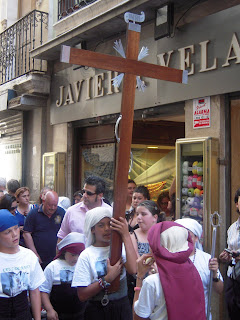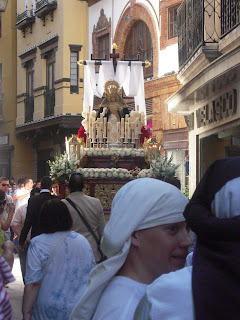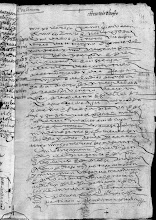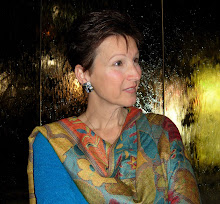In the last eight days, we’ve traveled twice by train to Cordoba. This is the place in Spain that speaks to my soul, and I know exactly why. It’s because of the wildly beautiful, haunting Mezquita: an eighth century mosque with a fourteenth century cathedral embedded in its center. It’s because of the evocative Sinogoga, the only one in Spain which today remains substantially intact after the Jews were expelled in 1492 by Ferdinand and Isabella … yes, the same year Christopher Columbus sailed to the New World. It’s because of the archaeological museum, which houses not only Roman and Visigothic ruins, but proto-historical artifacts (defined as “end of the second millennium to the second century BC”) like the stunning stone and bronze ex-votos (sculpted offerings of personal gratitude to the gods) which mesmerized me today.
And it’s because of the people who live in Cordoba, two of them in particular: the storyteller and the gypsy.
The storyteller was in the museum, relating a tale in Spanish from
A Thousand and One Arabian Nights to an entranced group of children. He was dressed in a long, white robe and a purple turban, and was such a gifted, enthusiastic raconteur that Bill and I lingered to listen to him. He had only one prop … a “genie” oil lamp … but he spoke in voices and added startling sound effects so that we understood which story he was telling. My heart aching, I wished that Cooper had been there to sit amongst the children. I wished my advisor, Dr. Francis, who is a fabulous yarn-spinner in his own right, had been there. But, alas, they were not, and all too soon his story had ended.

I first saw the gypsy when we were in Cordoba last weekend. She was sitting on the cobblestone street outside the Sinagoga with her three children, begging. I emptied my wallet then, giving her everything I had, which was only coins. Friday, on our second trip to Cordoba, I saw her on four separate occasions during the day. The first time, I felt annoyed. She approached me, plaintively, and I wagged my finger at her, chiding, “I gave you money last week!” Bill and I walked on and I told him, “It’s just not the same the second time.” But I couldn’t stop thinking about her. Her face and her voice were deeply compelling.
The next time I saw the gypsy, I clandestinely snapped a picture as we were walking down the street. She was nursing her youngest child while she appealed to the passersby, but I gave her nothing. When we turned the corner, I stopped to see the photograph. My memory card was full, however, and the image was not on it. Oh well, I thought, and walked on.
Despite the joy we felt while exploring the streets of Cordoba, I could not stop thinking about the gypsy woman. I kept mulling things over in my mind. She gets up in the morning and goes to work doing the only thing she can do with her three children in tow. I went to work for years doing the only thing I knew. How are we different? She takes care of her children; I took care of mine. It’s only luck or opportunity or fortune or karma that she is on the street begging, and I am driving around Jacksonville in a BMW.
So we went back to the Sinagoga after lunch on Friday, looking for her. That time, I gave her five Euros in trade for her photograph. She thanked me in a language I didn’t understand then and can’t identify now. Her children thanked me. When I saw her for the fourth time she recognized me and begged for more money … or maybe she just thanked me again. I don’t really know.

I told Bill on Saturday morning that I had to find her again before we left Cordoba, and he understood. That afternoon, after we visited the museum and wandered through the narrow, medieval streets, we returned to the Sinagoga but she wasn’t there. I was crestfallen. “Wait,” Bill said. “She’ll be here when the Sinagoga reopens at 3:30.” So we lingered in the stifling heat for half an hour, listening to a man in the lane playing flamenco music and Led Zepplin on his guitar.
At 3:25, she appeared. By then, I saw her as beautiful. I pressed my back against the stone wall to watch while she parked her ragged stroller and sat down on the edge of the street, laying her toddler across her lap while she changed his diaper. That was different. Last weekend, he had no diaper. Bill and I watched as tourist after tourist walked by her, indifferent to her entreaties, her children crouched beside her. After a couple of minutes I couldn’t stand it any longer, so I asked Bill to walk with me. Approaching her, I knelt down in the street, handing her ten Euros. Her children began jumping up and down and the gypsy grasped my hand and kissed it. I was horrified by her deference. “No,” I said, “I just want to buy your photograph.”
I snapped one, and then her children posed for a second photo. As I knelt there, the baby wrapped his arms around my neck. I could smell him and I didn’t really want the children to touch me, an admission that shames me. I handed the woman another ten Euro bill. She tried to kiss my hand again but I pulled it away from her; understanding, she reached out to me instead. She pressed her cheek against mine, murmuring unidentifiable words in her soft voice. We kissed each other and I began to weep. She broke my heart. I have so much, and she has so little.
It matters not to me if she is practiced in her craft. Before I became a student, I was certainly practiced in mine. We do what we must to survive. The gypsy mother in Cordoba does not know that with her begging, she has made me want to be a better woman (my apologies to Jack Nicholson's character in
As Good as it Gets).
























